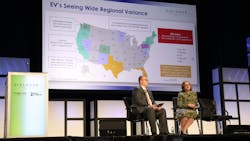Divided Congress opens door for executive branch agenda: MEMA
GRAPEVINE, Texas—A "divided" country and the divided U.S. Congress will make passing substantial legislation “much more difficult, if not almost impossible,” Ann Wilson, MEMA senior VP for government affairs, explained during last week’s Heavy Duty Aftermarket Dialogue here.
Given congressional gridlock, expect the Biden administration to pursue a climate-focused package of regulations; for commercial vehicles, that means emissions.
“A little over a year ago, Congress passed the bipartisan [Infrastructure Investment and Jobs Act],” Wilson said. “Then they passed the misnamed Inflation Reduction Act, as well as the CHIPS Act. But those bills actually started in the Senate where the Democrats had control, then they moved to the House where Nancy Pelosi needed to just get the minimal number of Democrats to kick it over the finish line and send it to a Democratic president. Obviously, that phenomenon no longer exists.”
Still, with proper messaging—with the heavy-duty vehicle industry making its case as being essential for the nation—targeted bills may have a chance, she noted. The key is to identify those members of Congress who are serious about serving their constituents, and explaining how the needs of the aftermarket industry align with the needs of their districts.
“I do think there's an opportunity with the right grassroots pressure to move specific pieces of legislation,” she said. “And this is why the executive branch and the regulatory power of the President become so very important. The President has an immense amount of authority and you're going to see this President exercise that authority over the next two years.
To do list
Among the items likely on the Biden administration’s regulatory agenda for the next two years, Wilson cited:
- greenhouse gas emissions
- fuel efficiency
- sustainability and Environmental, Social, and Governance (ESG) reporting; and
- changes in Labor Dept. regulations, which are like to be “very union friendly”
Additionally, with the federal government gridlocked, Wilson anticipates states will be “very, very active” in developing legislation, such as laws regarding autonomous vehicles.
“Congress has worked for years to try to create [autonomous vehicle] legislation, and they're going to keep trying,” Wilson said. “But you will see states like California continue to extend their AV program, because Congress hasn’t acted, states will fill in that gap.”
Uncertainty
When it comes to new laws and regulations, the third branch of federal government has a role as well, Wilson noted.
“We do have a very activist Supreme Court,” she said, pointing to recent court decisions that overturned the Biden Administration’s workplace testing and vaccine directives, and limited the ability of federal agencies to impose climate goals without direction from Congress, in the case of West Virginia v. EPA.
Still, Wilson expects many new federal rulemakings and regulations to roll out early this year—"because they have to finalize those regulations before a new Congress and a new President can overturn them.”
“That’s why this year, from a regulatory perspective, is definitely going to be the year of fuel efficiency,” she said.
In the works
Among the bullet points on Wilson’s slides for the regulatory agenda in Washington and around the country, she noted first President Biden’s Executive Order directing EPA and NHTSA to establish “multi-pollutant standards”:
- Directs EPA to propose rulemaking to establish NOx for heavy-duty vehicles beginning MY2027 and extend through at least MY2030 (finalizing no later than Dec 2022)
- Directs EPA to consider impact HD zero-emission vehicles might have in reducing emissions from certain market segments, update GHG beginning MY2027 through at least 2029.
- Directs EPA and DOT to look at GHG and fuel efficiency standards for medium and heavy vehicles in MY2030, as well as fuel efficiency standards for HD pickup trucks and vans beginning MY2028 through at least MY2030 (completed no later than July 2024); and
- Directs EPA and DOT to coordinate with California.
As for the just-published EPA NOx rule, Wilson noted that at, at more than 1,000 pages, “it’s sure to put you to sleep if you’ve got insomnia.”
For heavy-duty engines, the rule is a combination of:
- the most stringent MY 2027 standards proposed,
- longer useful life periods compared to today's useful life periods,
- targeted, interim compliance allowance approach to in-use compliance testing, and
- the extended durability demonstration for emissions control technologies
For medium-duty engines, the rule is a combination of:
- the first three elements above (i.e., most stringent MY 2027 standards proposed, increase in useful life periods, and interim compliance allowance for in-use testing)
- EPA specifically found that each "is appropriate, feasible, and consistent with our CAA authority to set technology-forcing NOX pollutant standards for heavy- duty engines for their useful life."
- Appears to be in alignment with MEMA's primary concerns.
“This is really important, and it's really important for a couple of reasons for all of you,” she said. “First of all, MEMA did pretty well on the rule, on a cursory look. We had different models to pick between, and they have both a heavy vehicle rule and a medium vehicle rule. So we think we came out pretty well for the industry.”
Additionally, Wilson encouraged MEMA members to join the working groups that are developing formal comments in response to the rulemakings. The organization also is developing an analysis to be distributed to members.
“I will tell you there are some in the engine manufacturing arena who are a little concerned about the out-of-cycle testing on this. I'm not exactly sure how that's going to fall through as they move through the whole piece," Wilson said. "EPA is very, very specific. They think this is attainable; they think it makes sense, they think it's feasible.”
And then there’s California, and the California Air Resources Board.
“They have proposed new regulations for heavy vehicles where they want to see a zero emissions fleet by 2040—and that is operated in the state,” Wilson said. “So this is really important: Are we going to have vehicles to go all the way up to the border of California, and then [change trucks] to take that last mile?”
Wilson did remind, however, that the Biden administration wants California and the EPA to work together on these rules.
“We're all in favor of that because we don't want one set of regulations for the United States and one set of regulations for California,” Wilson said.
Indeed, she noted how California’s rules for zero-emissions vehicles have spread across the country—made potentially even more confusing as some states that have adopted the light-duty vehicle rules have not adopted the emissions rules for commercial vehicles.
“This, folks, is what's at stake: This is going to transform this industry worldwide—not just in the United States, not just in California, not just in Virginia,” Wilson said. “It's going to change the industry worldwide. Some of you are going to be able to make it; some of you may not be able to make it.”

